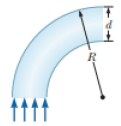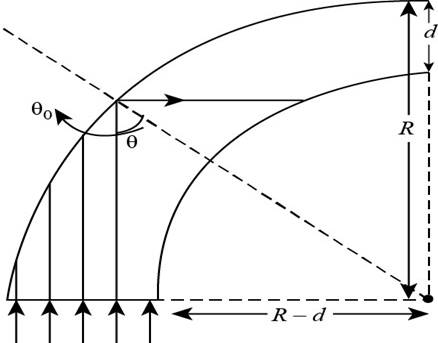
Concept explainers
An optical fiber has an index of refraction n and diameter d. It is surrounded by vacuum. Light is sent into the fiber along its axis as shown in Figure P34.31. (a) Find the smallest outside radius Rmin permitted for a bend in the fiber if no light is to escape. (b) What If? What result does part (a) predict as d approaches zero? Is this behavior reasonable? Explain. (c) As n increases? (d) As n approaches 1? (c) Evaluate Rmin assuming the fiber diameter is 100 μm and its index of refraction is 1.40.
Figure P34.31

(a)
Answer to Problem 35.49P
Explanation of Solution
Given info: The index of refraction is
The figure that represents the given conditions is shown below,

Figure (1)
From figure a ray originally moves along the inner edge will have the smallest angle of incidence when it strikes the outer edge of the fiber in the curve. Thus, if this ray is totally internally reflected, all of the others are also totally reflected.
The necessary condition for the ray to be total internal reflection is,
Here,
For very small value of
The above condition can be written as,
The expression of
Substitute 1 for the value of
The expression of
Here,
The expression of equation (1) becomes.
The minimum value of outside radius permitted for a bend in the fiber is
Conclusion:
Therefore, the smallest outside radius
(b)
Answer to Problem 35.49P
Explanation of Solution
The result from part (a) is,
Here,
The value of
The lesser value of
The thinner the optical fiber, the radius up to which the fiber is bent becomes smaller.
Conclusion:
Therefore, the
(c)
Answer to Problem 35.49P
Explanation of Solution
As
Here,
The above expression can be written as,
It is clear that as
Yes, as
Conclusion:
Therefore, the
(d)
Answer to Problem 35.49P
Explanation of Solution
As
Here,
The above expression can be written as,
It is clear that as
Yes, as
Conclusion:
Therefore, the value
(e)
Answer to Problem 35.49P
Explanation of Solution
Given info: The diameter of the fiber is
Explanation:
The formula to calculate the
Here,
Substitute
Conclusion:
Therefore, the value of
Want to see more full solutions like this?
Chapter 35 Solutions
EBK PHYSICS FOR SCIENTISTS AND ENGINEER
- How many times will the incident beam in Figure P34.33 (page 922) be reflected by each of the parallel mirrors? Figure P34.33arrow_forwardLight is incident on a prism as shown in Figure P38.31. The prism, an equilateral triangle, is made of plastic with an index of refraction of 1.46 for red light and 1.49 for blue light. Assume the apex angle of the prism is 60.00. a. Sketch the approximate paths of the rays for red and blue light as they travel through and then exit the prism. b. Determine the measure of dispersion, the angle between the red and blue rays that exit the prism. Figure P38.31arrow_forwardA 16.0-cm-long pencil is placed at a 45.0° angle, with its center 15.0 cm above the optic axis and 45.0 cm from a lens with a 20.0 cm focal length as shown in Fig. P34.106. (Note that the figure is not drawn to scale.) Assume that the diameter of the lens is large enough for the paraxial approximation to be valid. (a) Where is the image of the pencil? (Give the location of the images of the points A, B, and C on the object, which are located at the eraser, point, and center of the pencil, respectively.) (b) What is the length of the image (that is, the distance between the images of points A and B)? (c) Show the orientation of the image in a sketch.arrow_forward
 Physics for Scientists and Engineers: Foundations...PhysicsISBN:9781133939146Author:Katz, Debora M.Publisher:Cengage Learning
Physics for Scientists and Engineers: Foundations...PhysicsISBN:9781133939146Author:Katz, Debora M.Publisher:Cengage Learning Physics for Scientists and Engineers with Modern ...PhysicsISBN:9781337553292Author:Raymond A. Serway, John W. JewettPublisher:Cengage Learning
Physics for Scientists and Engineers with Modern ...PhysicsISBN:9781337553292Author:Raymond A. Serway, John W. JewettPublisher:Cengage Learning Physics for Scientists and EngineersPhysicsISBN:9781337553278Author:Raymond A. Serway, John W. JewettPublisher:Cengage Learning
Physics for Scientists and EngineersPhysicsISBN:9781337553278Author:Raymond A. Serway, John W. JewettPublisher:Cengage Learning College PhysicsPhysicsISBN:9781305952300Author:Raymond A. Serway, Chris VuillePublisher:Cengage Learning
College PhysicsPhysicsISBN:9781305952300Author:Raymond A. Serway, Chris VuillePublisher:Cengage Learning Principles of Physics: A Calculus-Based TextPhysicsISBN:9781133104261Author:Raymond A. Serway, John W. JewettPublisher:Cengage Learning
Principles of Physics: A Calculus-Based TextPhysicsISBN:9781133104261Author:Raymond A. Serway, John W. JewettPublisher:Cengage Learning Physics for Scientists and Engineers, Technology ...PhysicsISBN:9781305116399Author:Raymond A. Serway, John W. JewettPublisher:Cengage Learning
Physics for Scientists and Engineers, Technology ...PhysicsISBN:9781305116399Author:Raymond A. Serway, John W. JewettPublisher:Cengage Learning





